State of Misinformation 2021- United States
Despite the internet being our major source of information we turn to in our daily lives, misinformation still abounds. It’s not just a few unchecked facts that are the issue, but content deliberately created to deceive the reader into believing a lie, usually intended to disparage someone or something, to trick people into believing one side or viewpoint, or even just to create chaos.
Fake news isn’t limited to made-up stories. It can also be manipulated photos or videos, fake or cloned news sites, using images out of context, or passing off parody accounts as real accounts. This engineered content is typically highly shareable, and can go viral before anyone checks to see if it’s even real. And that’s the problem.
Fake news has already fostered a lot of mistrust around what people see online, and even credible news sites and sources of information are now being questioned as to their validity, or simply accused of spreading fake news with no basis for the claim.
Has media been tainted past the point of no return, and has fake news permanently damaged the trust of news consumers? Or is the problem of fake news simply forcing us to face what we’ve known for a long time: There needs to be a solution for trust, transparency, and accountability on the internet.
Methodology
This report seeks to understand the everyday encounters people have with fake news on the internet, how it’s impacted their behaviors and decisions, where they find it most, and how much of a threat they believe fake news to be.
A similar study has been conducted by us also in Europe and one specifically in the Netherlands. These reports can also be requested.
On December 8, 2020, we surveyed 1000 people living in the US from all walks of life to get their assessment of the fake news problem — and to get their thoughts on how to solve it.
Key Findings
Our survey uncovered a number of important key findings around where people go for news, how confident they are that they’d recognize fake news, and the actions that would most increase their trust in the content they saw on the internet.
People were overconfident in their ability to spot fake news. 93.3% of our respondents were confident they could spot fake news, yet many still accidently shared it — showing that perhaps they couldn’t spot fake news as easily as they thought.
They believe they only see it a few times per week. 55.9% of respondents believed they only encounter fake news up to five times per week on social media, which means it’s either not the problem they think it is, or they’re just not aware they’re seeing it.
Fake news is more of a threat to society than terrorism. From impacting daily decisions to influencing elections, our respondents were concerned about how great of a threat fake news is to society.
Fake news impacted the 2020 Presidential elections. 70.4% of our respondents believe fake affected the Presidential elections, and 77.9% believe it affected elections in general.
Fake news is causing more people to fact-check. 38.8% now fact-check more as a result of fake news, and if faced with misleading information on a website, 63.2% will attempt to verify it.
The most encountered fake news is manipulated content or authentic material used in the wrong context — which are both visually-based. Respondents also encountered fake information, imposter news sites, fake news sites, and parody content.
Search engine returns were more trusted than social media posts. Our respondents trusted search engines to bring them more accurate and truthful information, most likely because they could see the source it’s coming from.
Increasing transparency is a way to solve the fake news problem. While respondents had different thoughts on how the problem could be solved, they agreed that increasing transparency around authorship, sources, and documented changes would increase their trust in the content.
The problem can be solved but will require government intervention. 39% of respondents believe that the problem of fake news on the internet can be solved. 47% of respondents believe that the government and regulators will need to get involved in order to see the problem addressed.
Criminalization of fake news. Over two thirds of respondents said they would support regulations that made it a crime for people and organizations to knowingly create and share fake information.
Part 1: Profile of Who We Surveyed
Where we get our news from and how we get it is changing. Where once people relied on print newspapers and radio, we now rely on sound bites and social media posts. With the gatekeepers of news lessened, and with so many people having access to freely post online, fake news or misleading information has become a concern for many. We wanted to know if our respondents could identify fake news when they saw it — and when they didn’t.
Who we surveyed
Our 1000 survey participants were from the US, and they ranged in age from 16 to over 54, with the majority of our participants between the ages of 35 and 44 (35.7%). The gender split skewed female (53.6%). Our participants also had varying income levels, worked in various industries, and had various education levels, representing a microcosm of those who would be encountering fake news on a daily basis.
Where people get their news from has shifted in the past 12 months
Where were you getting your news last year, and are you getting your news from the same place this year? News consumption sources didn’t change a significant amount, but we found that the primary sources of people’s news updates switched. Last year, our respondents cited TV as their primary source of news (38.8%), with social media the second preferred place (29.1%). This year, they swapped. Now, our respondents use social media as their main source for news, with an increase of 6.2%, with TV dropping by 7.4%. While the change is small, it may show a lack of confidence in TV news and a rising trust in social media.
The third largest source of news — directly from an online media source’s website — also rose this year, up by 2.2%, which could signal an increase in respondents wanting to get closer to the source of their news.
Other sources that shifted include print newspapers going down from last year (6% to 4%), podcasts going up slightly (2.1% to 2.9%), radio reducing (4.5% to 2.7%), and YouTube increasing (4.2% to 6%).


They are (over)confident they can spot fake news
Do you know fake news when you see it? According to our respondents, those disseminating fake news aren’t doing a good job at it, because 93.3% were confident they could spot it: 39.3% were very confident, and the majority of our respondents (54%) were somewhat confident they could spot fake news. The rest were not confident at all.
It begs the question, though, that if fake news is deliberately created to fool and mislead readers into believing it’s the truth, would they be able to spot it? Or is that the deception, that readers think they’re identifying fake news when in reality they’re really being lured by it?
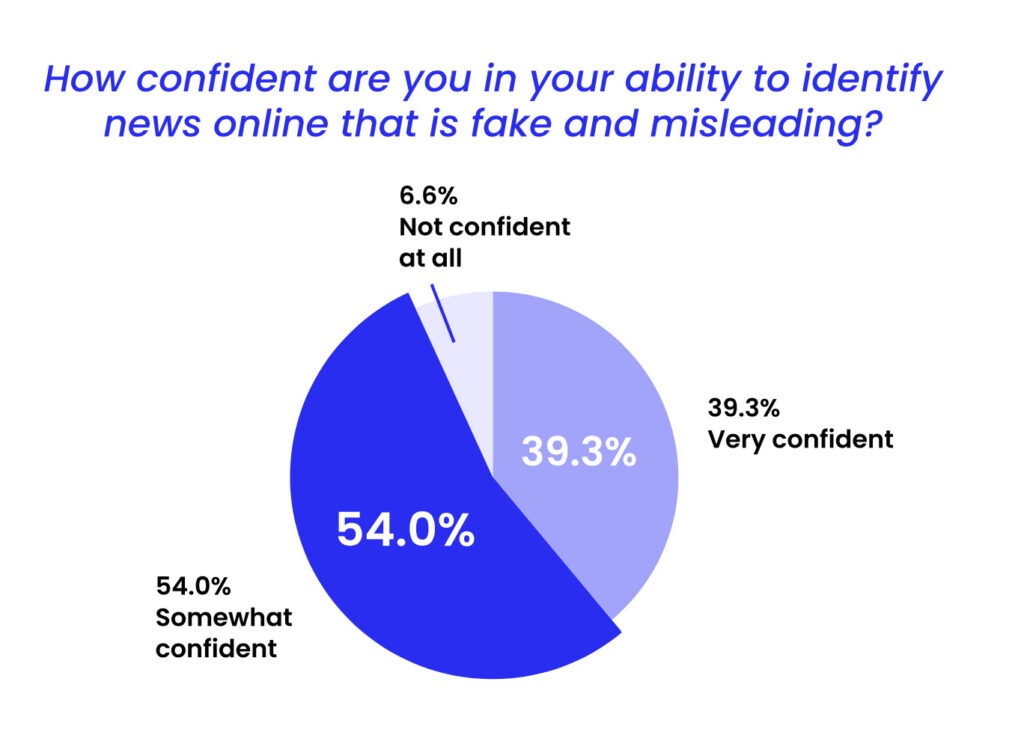
But they have also personally shared fake news by mistake
Have they ever mistakenly shared fake news? Our respondents were split, with 38.2% saying yes, they have accidentally shared misleading news, and 37.3% saying they have not. The remainder either didn’t know if they had, or made it a point not to share news in general.
38.2% saying that they have shared fake news means that they didn’t recognize it as such when they shared it, and found out later that it was misleading or false. This shows that despite 93.3% of our respondents saying in the last question that they had some level of confidence that they’d know fake news when they saw it, they actually aren’t recognizing it when they see it — and this is a big problem.
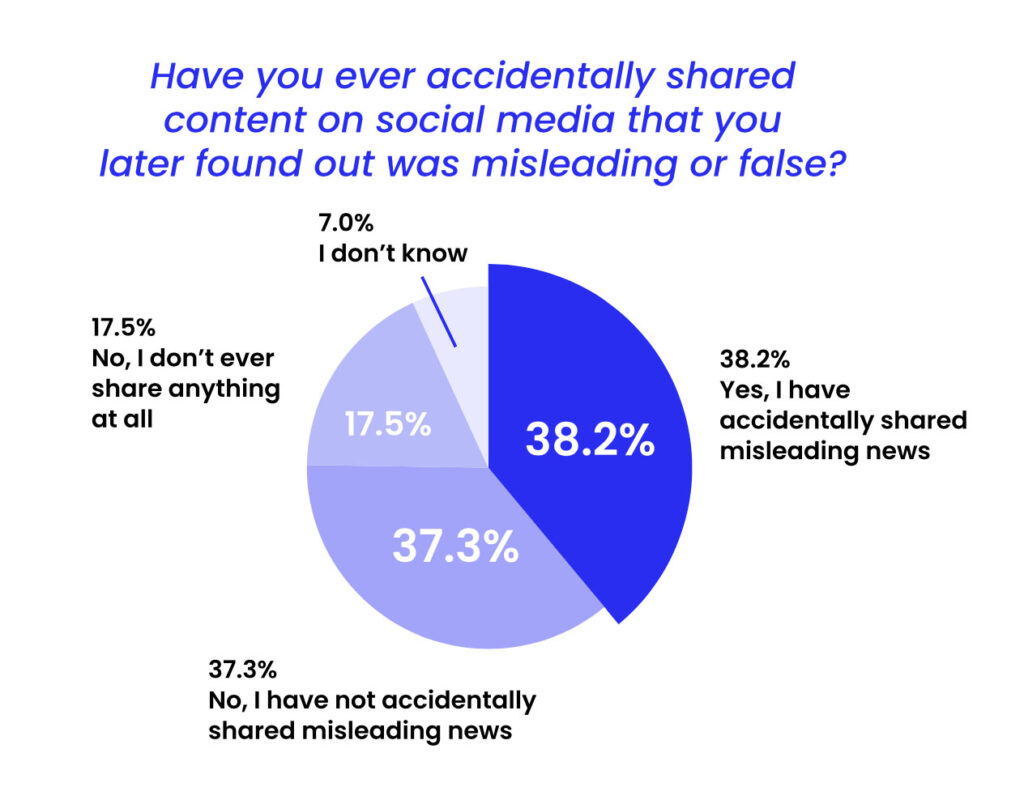
Summary
Even though sources of news consumption have shifted — from TV being the primary source to social media — our respondents are confident that they can identify fake news or misleading information when they see it. Still, a number of them didn’t recognize it enough to make the mistake of sharing it, which speaks to the deception and lure of false content that seems real.
Part 2: Encounters with Fake News and Misinformation
We know that fake news is out there, and that our respondents have encountered it. We wanted to learn more about where they’ve encountered it, where they’re encountering more or less of it, and exactly what kind of misinformation they’ve encountered.
Encounters with fake news on social media
Fake news is known to spread wild on social media, so we wanted to know about our respondents’ experience with it on various social platforms like Facebook and Twitter. The majority of our respondents believed that they only encountered fake news one to five times per week (29.9%) — that’s at most one post per day as they scroll. Our next largest group of respondents were confident they encountered intentionally misleading news very rarely. Overall, 55.9% of respondents believed they only encountered fake news up to five times per week — which either means they believe there isn’t a lot of it out there, or they’re not recognizing it when they see it.
A lower percentage (32.8%) believed they encountered misleading news a lot more: six to over 20 times per week. 7.8% didn’t know if they saw misleading news or not on social media, and 3.4% don’t use social media.

Encounters with fake news on search engines
Are search engines more reliable than social media? Yes, according to our respondents: 24.3% believed that they very rarely encounter misleading news through search engines like Google, Bing, Yahoo, and others — 7.2% higher than their rating for social media. 60.6% of respondents believed they only encountered fake news up to five times per week, a bit more of a positive rating than social media.
Fewer (25.2%) believed they encountered misleading news over six times per week to over 20 times per week. 11.3.8% didn’t know if they saw misleading news or not on search engines, a bit higher than on social media.
The higher confidence in search engines could be due to the fact that respondents can see the source of their search returns and where the news is coming from, rather than on social media, where it may be shared without any attribution. We’ll see later that this is indeed a way respondents want to increase trust in online content.

The six types of fake news people may encounter
According to The Columbia Journalism Review, there are six types of fake news: authentic material used in the wrong context, imposter news sites designed to look like brands we already know, fake news sites, fake information, manipulated content, and parody content.
We asked our respondents which kind they saw the most today. They saw manipulated content the most (26.8%), which are photos and videos that are doctored, Photoshopped, or that contain deep fakes. They also saw authentic material used in the wrong context almost as much (24.3%), which are videos or photos from some other event and time that are said to be from today to mislead the viewer. It’s worth noting that these two top kinds of fake news content are both visually-based, and may be more noticeably misleading than text-based news.
Respondents also encountered fake information (19.3%), imposter news sites designed to look like brands we already know (15.1%), and fake news sites (11.7%), with parody content the least encountered (2.9%). Again, these are the ones that our respondents noticed and identified as fake news. But what about the others that appeared real to them? Did they notice this content was fake, or was it pointed out to them by someone else after the fact?
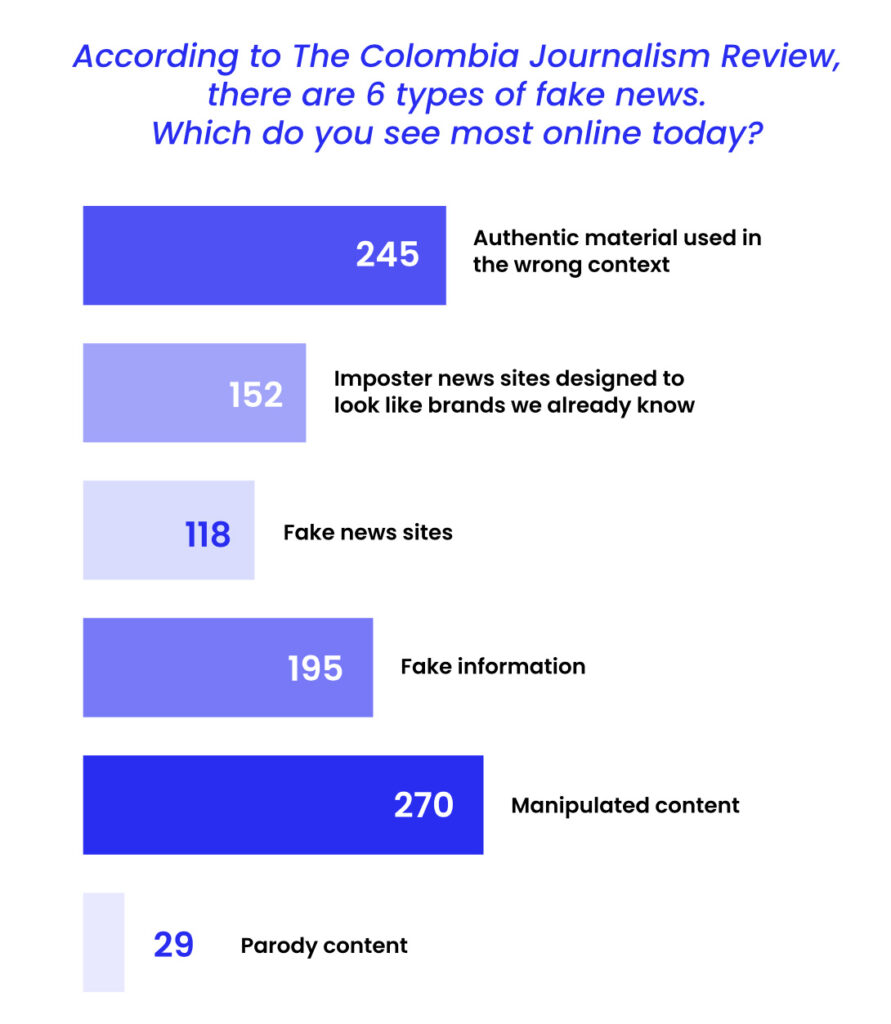
Summary
In evaluating where to find fake news on the internet, our respondents were more confident that search engines provided more trustworthy returns than social media. Of the different kinds of fake news out there, our respondents identified seeing more visually-based altered or manipulated posts over false information or websites.
It’s worth noting that we begin to see increasing replies of “I don’t know” — unsure of where fake news can be found, what it is, and how to solve it — which, as we’ll see, become more prevalent as we go in our responses.
Part 3: Trust on the Internet
At the root of fake news is trust. If you trust the author or the source, or if the information is from a reputable, legitimate site or organization, you know it’s not fake. Right? We wanted to get more insight into what kind of sites, sources, and content our respondents had confidence in.
Trusting websites with professionals behind them
First, we wanted to gauge the level of trust our respondents had across different types of websites, and how they rated as reliable, trustworthy sources of information. The highest trusted websites were medical websites like hospitals and pharmacies (42.7%), followed by government websites (35.9%), legal websites (33.2%), and financial websites like banks and investment firms (28.2%). In other words, websites with certified or trained professionals behind them.
eCommerce sites ranked lower (17.5%), perhaps due to mistrust around sales pitches or sales copy, or perhaps the lack of certification or vetting ecommerce sites need to be held to. The overall internet ranked the lowest at 15.3%. This means that outside professional websites, confidence in seeing trusted content drops significantly.
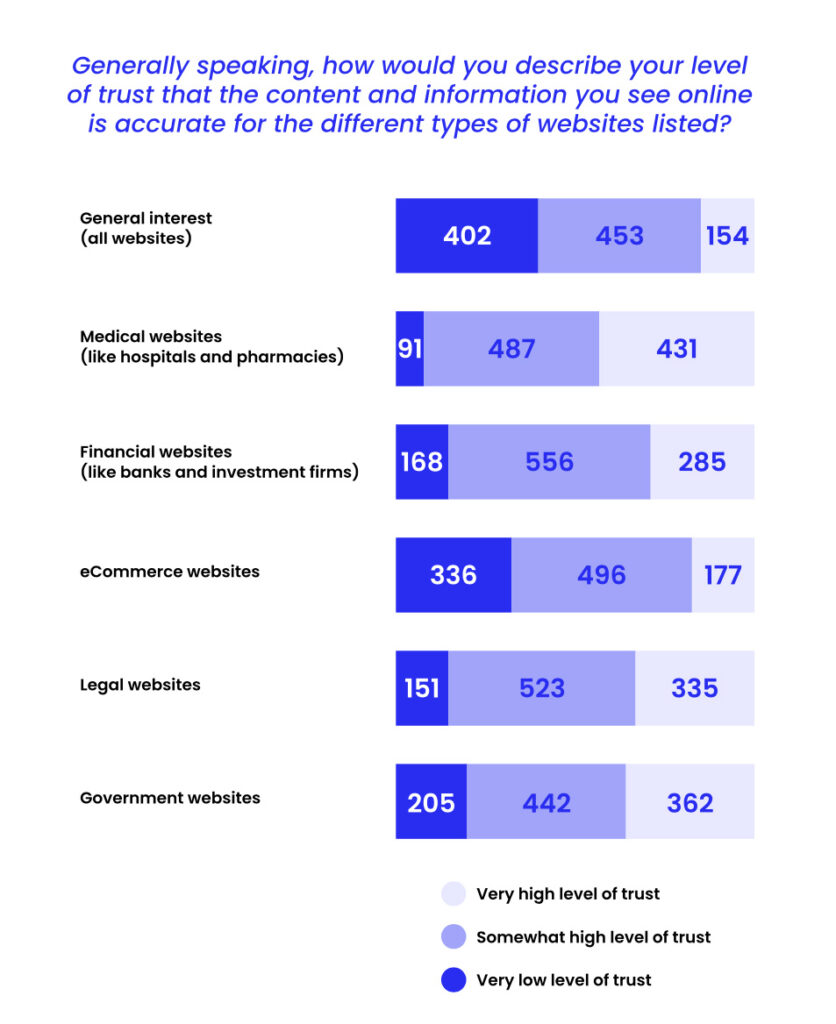
Who to trust to provide accurate news
Who do our respondents trust for getting their news? We discovered some interesting finds when doing one-to-one comparisons, specifically that respondents still lean towards more traditional, legitimized, or institutional sources for their news — or say they do.
First, our respondents felt local news (59.9%) would by far provide more accurate news and information than national news (40.1%), perhaps because it’s more community-focused and knowledgeable about the everyday world around them.

Our respondents also found more confidence in traditional media (64.9%) like TV, newspapers, and online news sites to provide more accurate information than social media (35.1%).

As we saw above, respondents trust search engines (68%) to provide them more reliable information than they do social media (32%).

Respondents also found that broadcast TV media (59.5%) was able to be counted on more than online media (40.5%).

When it came to social media, our respondents felt that Facebook (59.9%) provided more accurate news and information than Twitter (40.1%).

But Facebook (20.3%) was no comparison to Google in terms of trusting accurate information (79.7%).

Which social media they trust the most
In focusing on social media, we wanted to know who our respondents trusted. The most trustworthy platform was Facebook at 29.4% (which also ended up being our respondents’ most distrusted platform, too). Considering Facebook is the largest social media site in the world and that most people are spending their time and attention here, it’s no surprise to see that it’s the source many people turn to.
LinkedIn was second at 20.2%. As a professionally-focused networking site, LinkedIn has a somewhat higher level of expectation for professional content (and this could relate back to our question about trust being higher for professionals).
Third was Twitter at 15.5%, which had been used this past year to share real-time pandemic-related updates and to organize community activism.
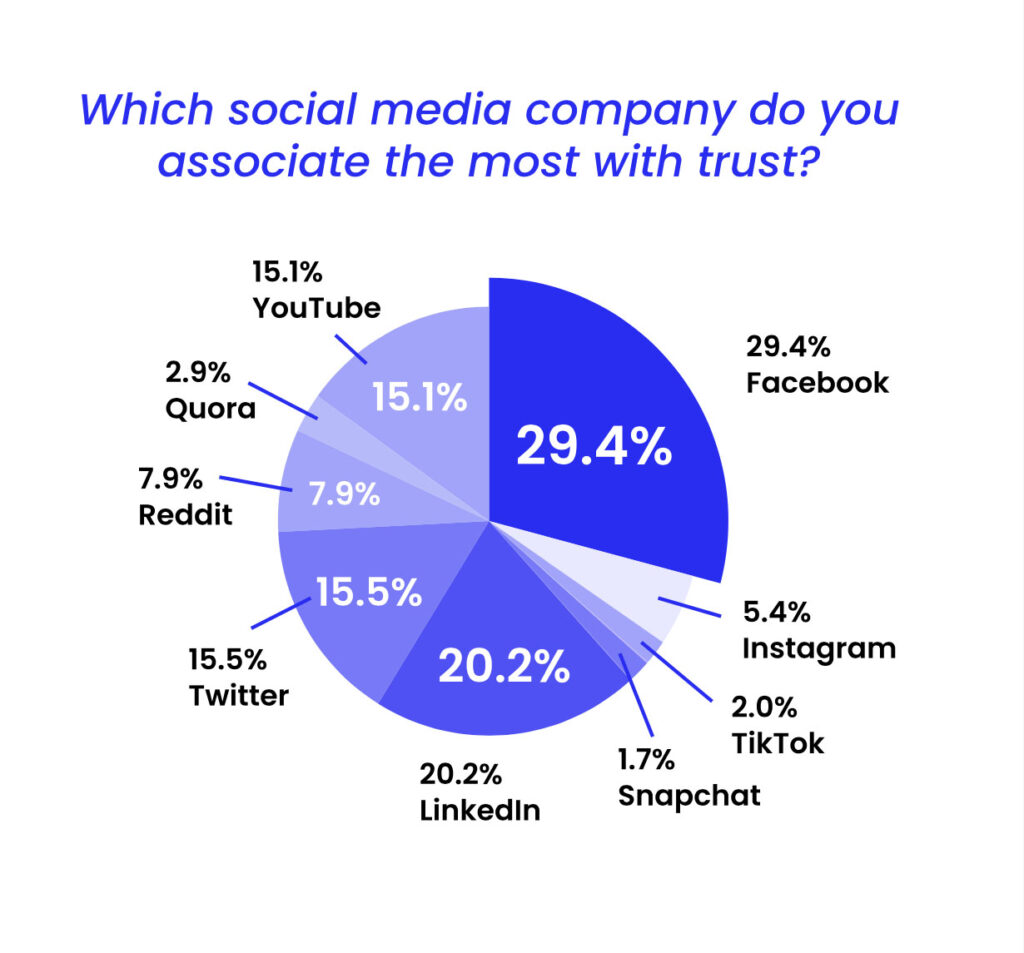
Which social media they trust the least
Surprisingly, the highest trusted platform, Facebook, was also the least trust platform, as rated by 37.1% of our respondents. This could signal a very real split in awareness around the platform, which not only is the main social media hub of the world but has come under fire for what kind of content they allow to be shared. What does it mean when a social media platform is creating polarizing experiences? Or, does this mean that those who use it find it trustworthy, while those who don’t use it believe it’s not? (To note, there was a small number of respondents who chose Facebook as both trustworthy and untrustworthy.)
We found the same situation with Twitter, which came in as the third trusted platform, and the third least trusted platform, at 14%. Again, this signals a polarized audience, or perhaps shows that those who use it find it trustworthy, and those who don’t, don’t.
The second less trusted social media platform is TikTok, at 23% of our respondents. The micro-video platform that caters to Gen Z came under scrutiny this past year for questions around its security. Again, are these TikTok users that are rating it untrustworthy, or observers who just know of TikTok from the news and distrust it because of that?

Summary
When we asked respondents about how much they trusted different sources, we were able to pinpoint a sliding scale: sources with certified or trained professionals behind them were more trustworthy than the general internet. Local news, search engines, traditional media, and broadcast media ranked higher on trusted content as well. When it came down to social media platforms, however, the same platforms were rated both trusted and distrusted — meaning that “trust” could come down to a matter of personal usage versus opinion.
Part 4: Impact of Fake News
Is fake news really that much of a problem? If 93.3% of our respondents can spot it, wouldn’t that mean that they could dismiss it and move on, and it wouldn’t have any impact on their lives? Actually, we found the opposite: Fake news did have an impact on behaviors and decisions, both positive and negative.
The personal impact of fake news on behavior
Fake news abounds, but what did our respondents do about it? We wanted to know how the rise of fake news impacted them, and found that a quarter of them (24.8%) felt it didn’t impact them at all.
The largest number of our respondents (38.8%), however, were impacted in a positive way: They’ve started checking facts more thoroughly, and took it upon themselves to corroborate sources and verify what they’re reading. They kept engaging, but wanted to make sure they did so in an informed way. The rest of our respondents, however, did not fact check and decreased their engagement by either reducing the amount of news they consume (15.1%), discontinuing to consume news from a specific outlet (10.6%), or by reducing the amount of time spent on social media (10%).

The personal impact of fake news on decisions
Now that we know fake news has prompted behavior changes, we wanted to know if our respondents believed fake news impacted their decisions. 43.7% believed that it didn’t impact their decisions at all, but nearly the same amount (39.9%) believed that it had. 16.4% didn’t know, which means that fake news might have impacted their decisions — they just weren’t aware.
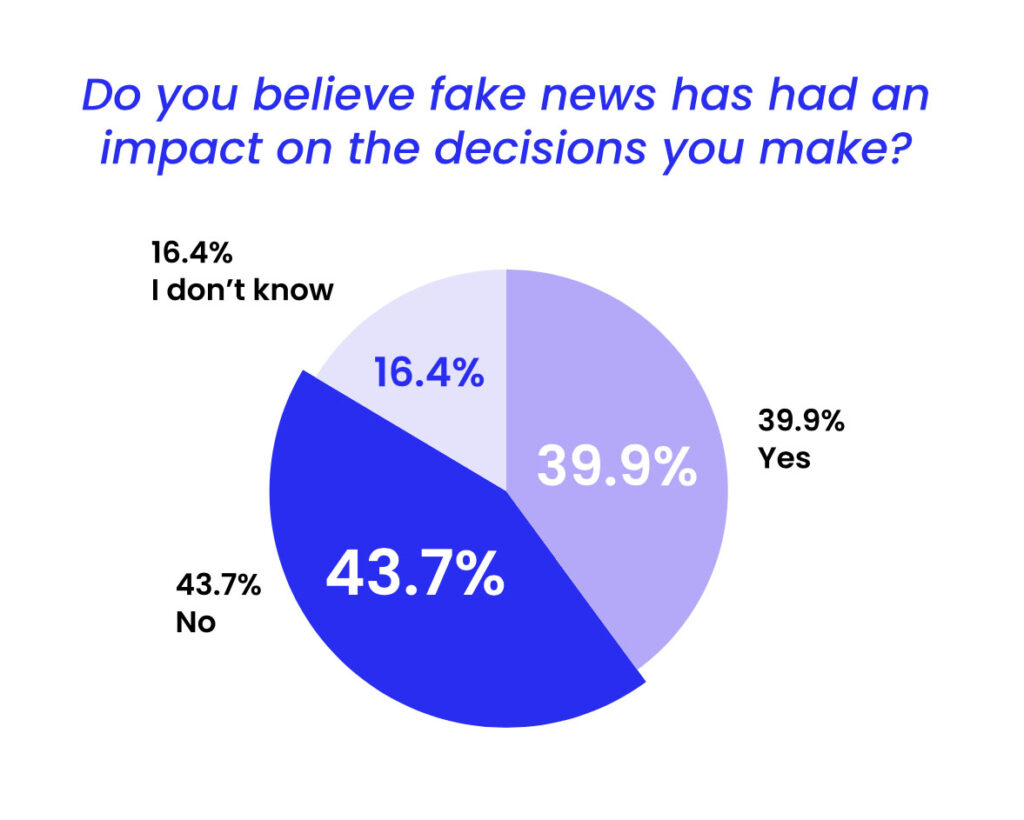
Responding to distrusted information
We wanted to hear how our respondents reacted when they found untrustworthy information on a website. In similar fashion as above, they check their sources. 63.2% responded that when confronted with misinformation, they seek additional information from other sources before continuing. But like above, the remainder continue without checking, or disengage altogether: 15.8% delay their actions or decisions, 10.4% continue but feel anxiety, and 5.6% simply continue without regard for it. A small percentage (3.6%) will mitigate any risk by using a false identity.
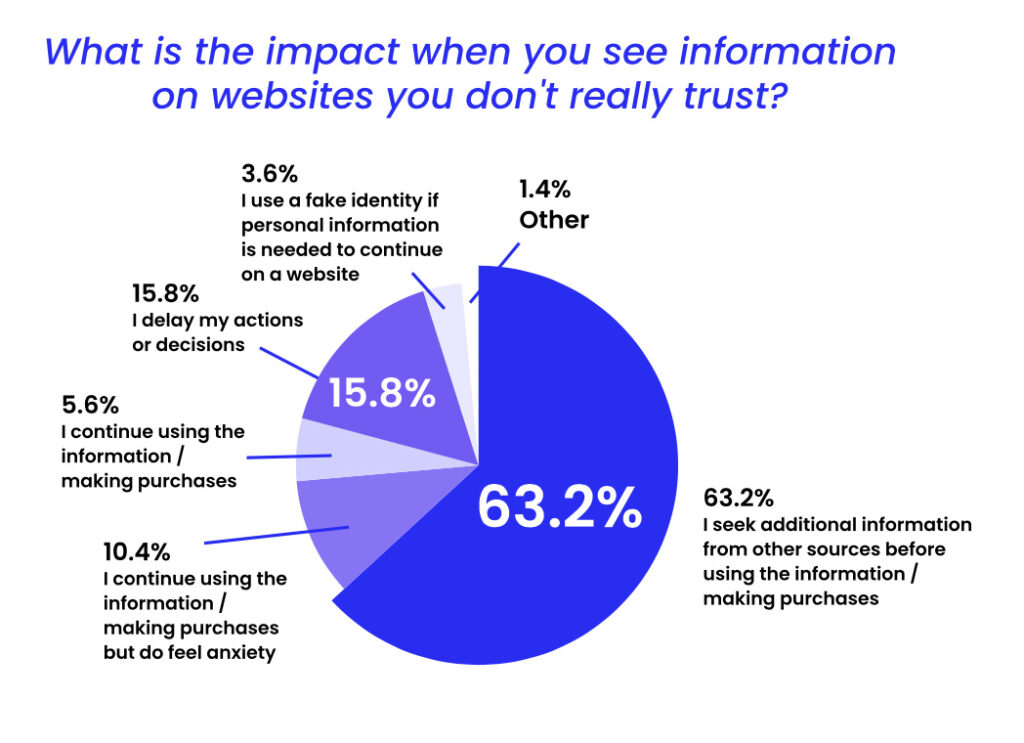
How big of a risk is fake news
We learned that fake news has caused respondents’ behaviors and interactions online to change. But how do they think fake news is affecting the world? Is it really that big of a threat?
Somewhat. Our respondents believe that fake news (55%) is a bigger threat than terrorism (45%)…

…but is not as big of a threat to society as data theft (56.6%)…

…or climate change (58%).

However, the narrow margins of these responses do indicate that our respondents believe fake news is a risk to be concerned about.
Fake new impacts elections — massively
2020 saw not only general elections but a Presidential election, which are typically high stakes anyway, but in the midst of a pandemic, the impact of those moving in and out of office would be significant. Did fake news have any impact?
Three-quarters of our respondents said yes, it did: A high 77.9% believe it affected elections in general, and 70.4% believe it affected the 2020 Presidential elections specifically.
This means that misleading information like the six mentioned above — authentic material used in the wrong context, imposter news sites designed to look like brands we already know, fake news sites, fake information, manipulated content, and parody content — influenced voters who couldn’t recognize it as fake, and therefore impacted the future of our country.
The remaining respondents were split between believing that fake news did not have an impact, and not being sure if it did.


Summary
Fake news does have an impact on behavior, and when faced with fake news, we found our respondents doing one of two things: They either did more research to better understand the news they were engaging with, or they didn’t want to engage at all.
When it comes to the threat fake news poses, we discovered that our respondents think that fake news does present a threat to society, edging out terrorism and being nearly equal to data theft and climate change. It’s also a big enough problem to have significantly impacted a Presidential election.
Again, we saw a high level of “I don’t know” responses to some of these questions, indicating uncertainty around recognizing fake news and understanding its impacts, or an unwillingness to commit to an answer.
Part 5: Solving the Fake News Problem
Fake news is misleading, deceptive, and a threat to society — but is it a problem we just have to live with? We wanted to engage our respondents to think about how the problem of fake news can be solved.
Solving the fake news problem — but how?
If fake news has such an impact on misleading the public, and is seen as a threat to society, then how do we solve it? Or rather, who should solve it? We asked our respondents who they trusted the most to solve the problem of fake news, and our largest response was in favor of fact-checking organizations (29.3%), which aligned with responses above about seeking out sources and verifying information. 19.7% believed that the responsibility is on traditional news media to solve the problem. The third largest response, at 16.8%, believed that the onus is on the individual to be responsible about what they post. Other suggestions included big tech companies like Facebook, Google, and Twitter (12.7%), the government or regulators (12.5%), open-source technology (4.4%), or small startups (1.8%).
Some of the responses in “Other” included having better media literacy or education, and putting the responsibility on all of us to call out fake news. A few, however, believed that nothing can solve the problem of fake news.

Is fake news anyone’s fault
We asked above who could solve the issue of fake news — but should anyone be held accountable? The majority of our respondents (31.1%) laid the blame on individuals who knowingly share fake information. But while 31.1% placed the blame on individuals, only 16.8% believed above that it was the individual’s responsibility to solve the problem of fake news.
News media and tech companies like Facebook and Google nearly tied at 28.1% and 28% respectively for the next big segment to be held accountable — perhaps because respondents felt they allowed fake news to spread — with the government and regulators at 12.7%.
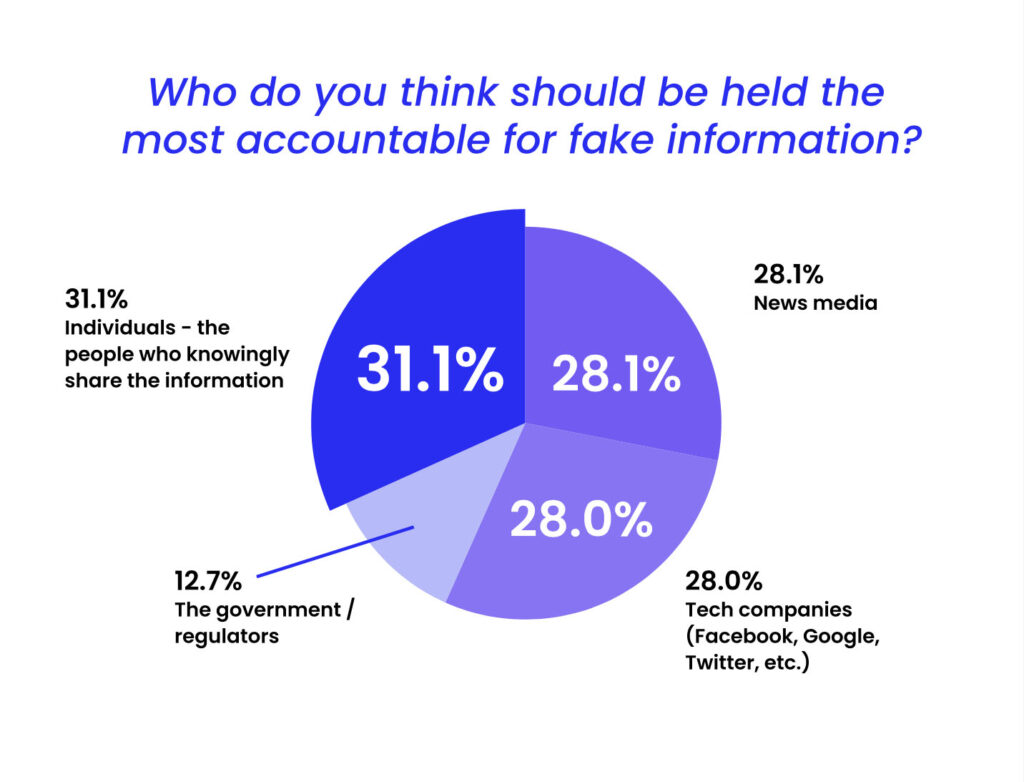
Should it be media or government
We dug in further and asked whether respondents thought it was up to the media or the government to solve the issue. Considering that fake news is inherently a media issue, only 30.6% believed that media and tech companies like Facebook and Google could solve this on their own. The majority of our respondents (47.1%) believed that the government and regulators would need to directly intervene into media and tech company practices to solve the fake news problem. Nearly a quarter (22.3%) weren’t sure of the solution.
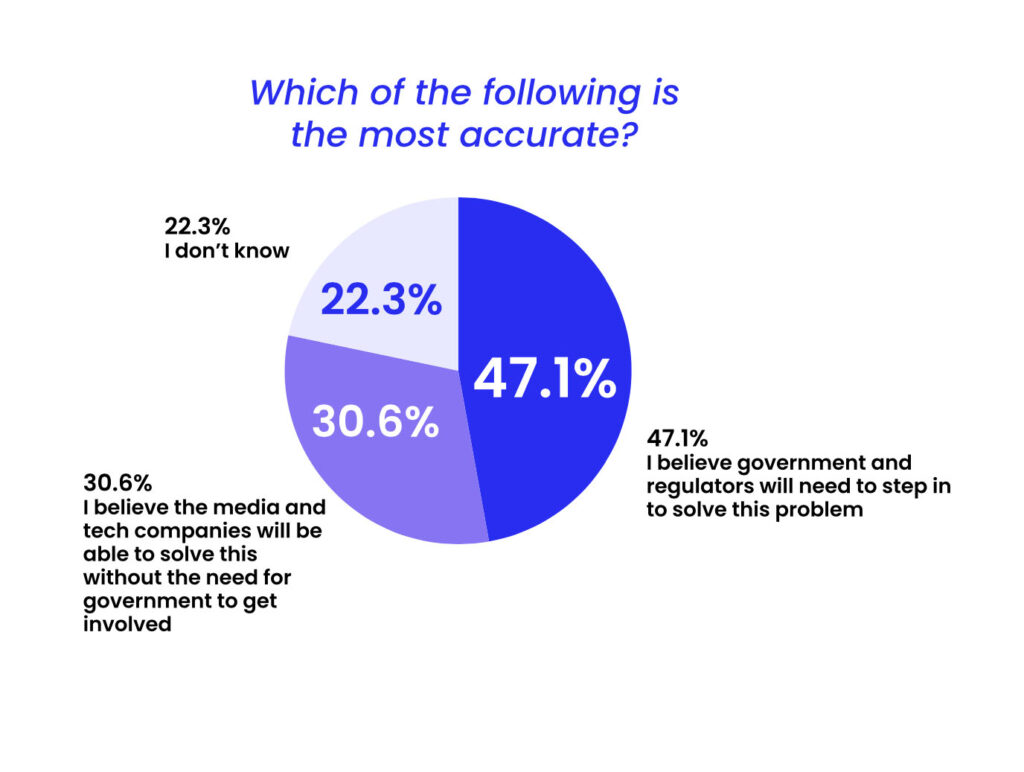
Is anyone addressing the problem of fake news in an effective way
Despite a good amount of our respondents believing that the government needed to step into media company practices to curb fake news, our respondents believed that the government was actually not doing a very effective job at addressing the problem of fake news over the past year. While our respondents rated news media outlets, tech companies, and the government somewhat equally on their handling of fake news, media actually edged out at being highly effective at handling fake news, with government and regulators edging out at not being effective at all. Still, respondents believed all three were only being somewhat effective.
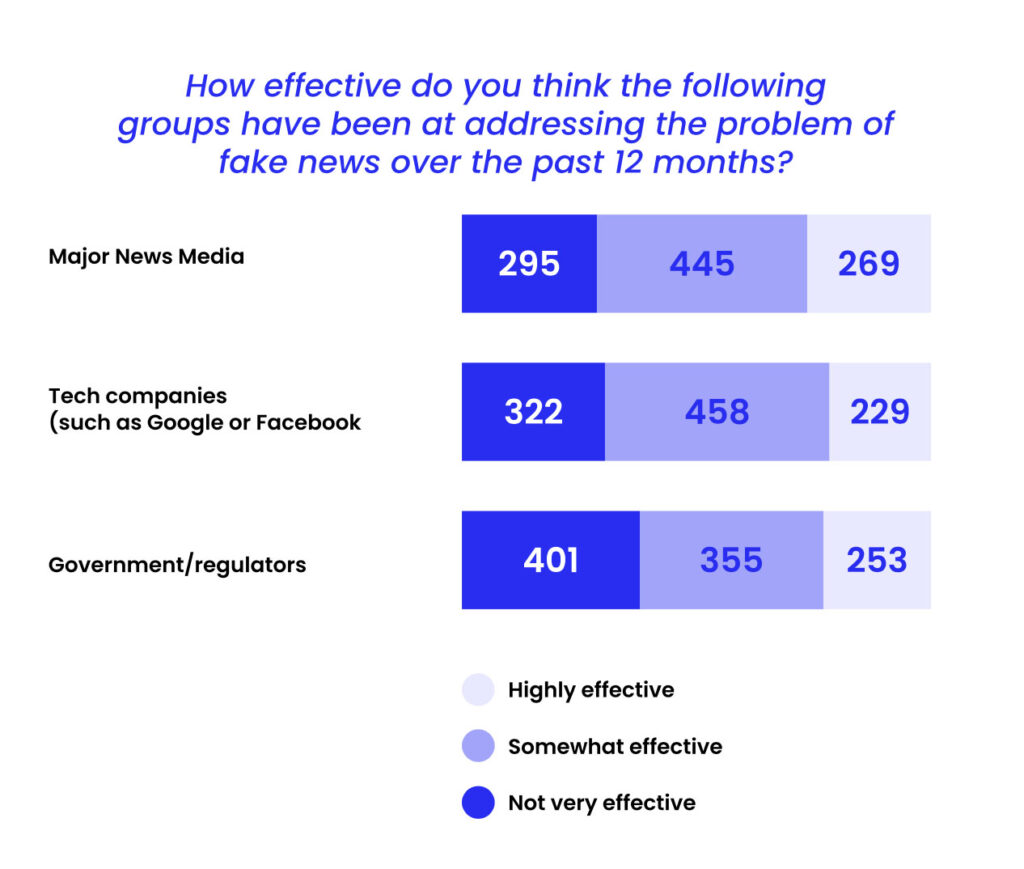
Should fake news be a crime
After what we’ve seen so far, it’s no surprise that the majority of our respondents (66.3%) would support regulation that made it a crime for individuals and organizations to knowingly create and share fake news. 17.6% replied that no, they wouldn’t support a regulation making it a crime (perhaps keeping First Amendment rights in mind), and 16.1% again didn’t take a side.

Solutions to Fake News: Increasing Trust Online
We wanted to ask our respondents a bit more about solutions for fake news, this time focusing around trust, transparency, and accountability. What would increase their trust in a piece of information they found on the internet? We saw above that a number of our respondents began checking sources and the veracity of the information they encountered, and similarly, the majority of our respondents (46.7%) cited that if they knew exactly what organization and author was behind the content, they felt they could trust it more. 32.6% felt they could trust the information if they saw exactly what changes had been made to the content since it was published. Finally, 17.6% wanted to easily research the reputation of the author.
While 3.1% responded as “Other,” their comments mirrored the same: They wanted to be able to easily research the information or verify the underlying data, have it be tied to reputable sources or cross-checked with them, or be verified as fact checked prior to publication.

Solutions to Fake News: Impact on Trust
Next, we wanted to gauge how much of an impact on trust the scenarios above would have. For the respondents, all scenarios would somewhat increase their trust of the content. But like the majority above, knowing exactly what organization and author was behind the content edged out on helping to significantly increase trust.

Solutions to Fake News: Trusting Unaffiliated Content
Considering that our respondents equated increased trust with being able to identify organizations and authors behind the content, we wanted to know what they thought about content that is not connected to an organization or author. Should that content be limited by search engines and media platforms? A little over half (53.4%) replied that they should be limited, with about a quarter (24.4%) replying that no, that kind of content should not be limited. The remaining quarter (22.2%) didn’t know.
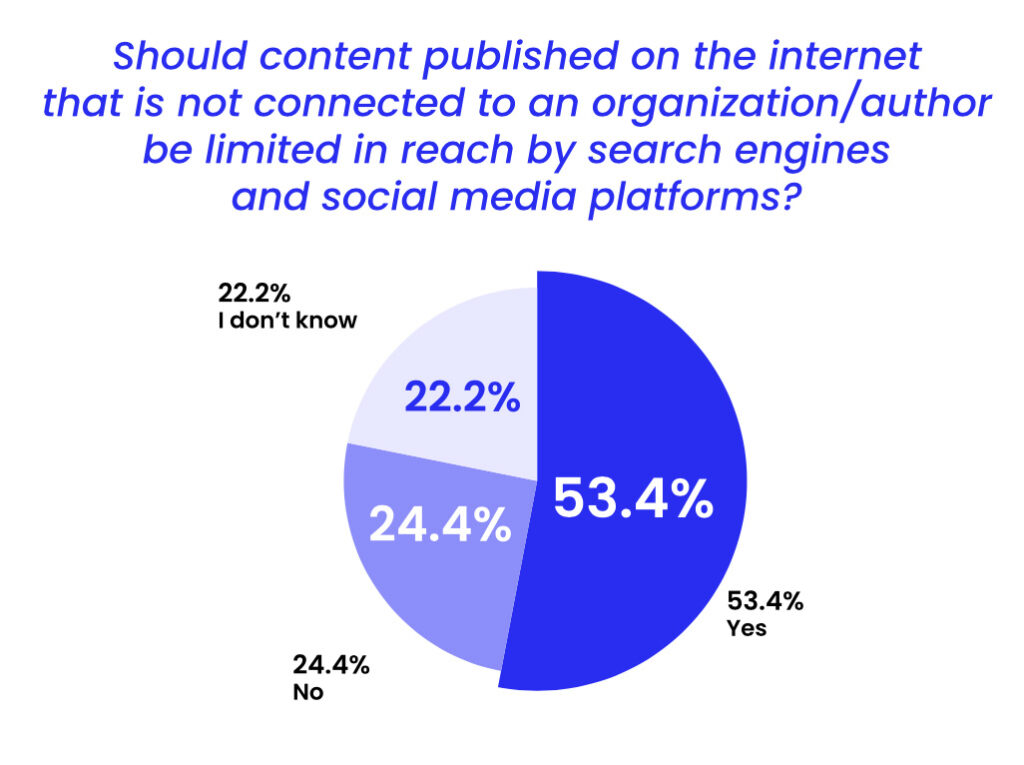
Solutions to Fake News: Trusting Required Documentation of Changes
Our respondents above replied that they’d feel a piece of content was more trustworthy if they could see the changes made to it since it was published. Should that be the standard for all content published on the internet? 65.8% believed that yes, it should be the standard, with the remaining respondents split between “No” (16.6%) and “I don’t know” (17.6%).

Summary
How do you solve fake news? More transparency, more facts, and more verified content, it looks like. Our respondents told us that their trust in a piece of content would increase if they knew where it was coming from, who wrote it, and how it changed since publication. Still, they were split on who should fix this problem, assigning responsibility to individuals and media sites, believing fact-checking organizations could stop the spread, or hoping that there’d be government intervention.
Again, our level of “I don’t know” responses was very high, meaning that there’s a lot of uncertainty around how to think about solving fake news, signaling that it’s either a problem that can’t be solved, or it’s not much of a problem to solve.
Part 6: Outlook For the Future
Is fake news here to stay? Maybe yes, maybe no, and it may get better, it may get worse… Our respondents were again torn over what the future of fake news will be.
Solving the fake news problem — can it be done?
Our respondents are split on that outlook. 39.4% edged out to say that yes, they believe fake news can be solved — and we saw above some suggestions for how. But 35.2% do not believe it can be solved, and that fake news is here to stay. The remainder (25.4%) didn’t know.
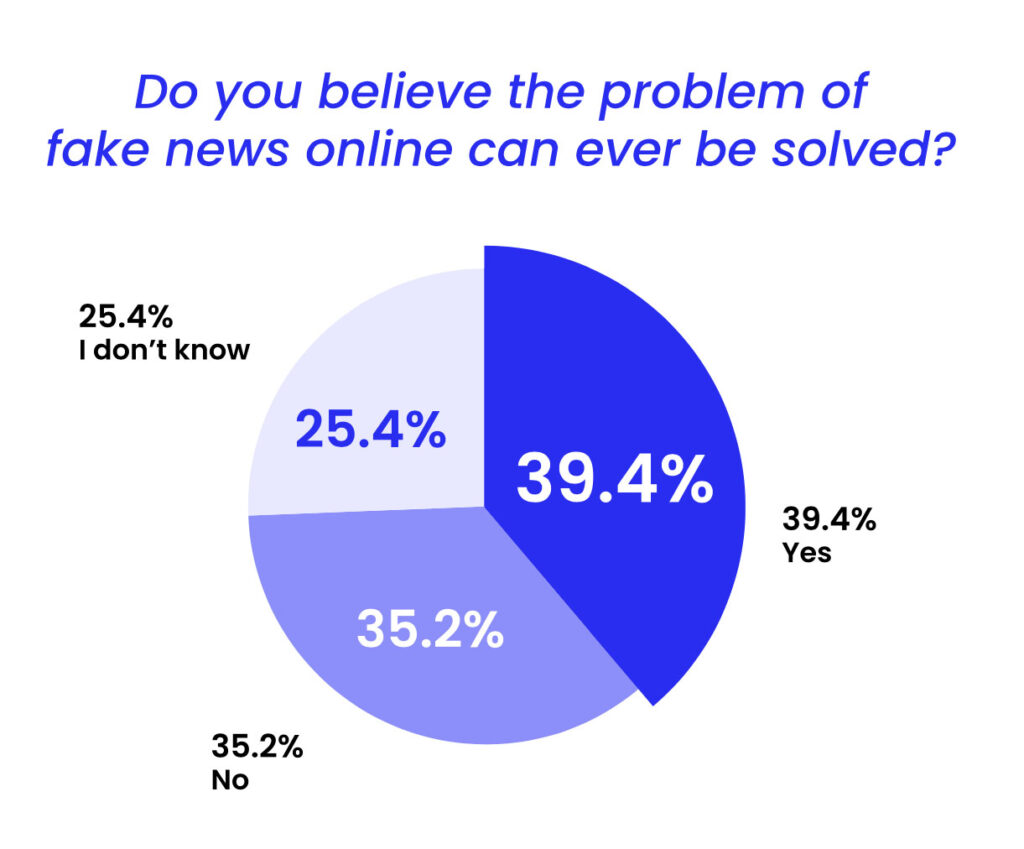
Will fake news continue to be an issue
Above we saw our respondents split on whether it could be solved. For this question, we see that our respondents are generally negative on the topic: Over the next five years, 35.5% see the fake news problem getting worse. 25.9%, however, are optimistic, and believe that it’ll improve, and that the issues will begin to be solved. 22.7% believed it would stay the same, and 16% didn’t know either way.
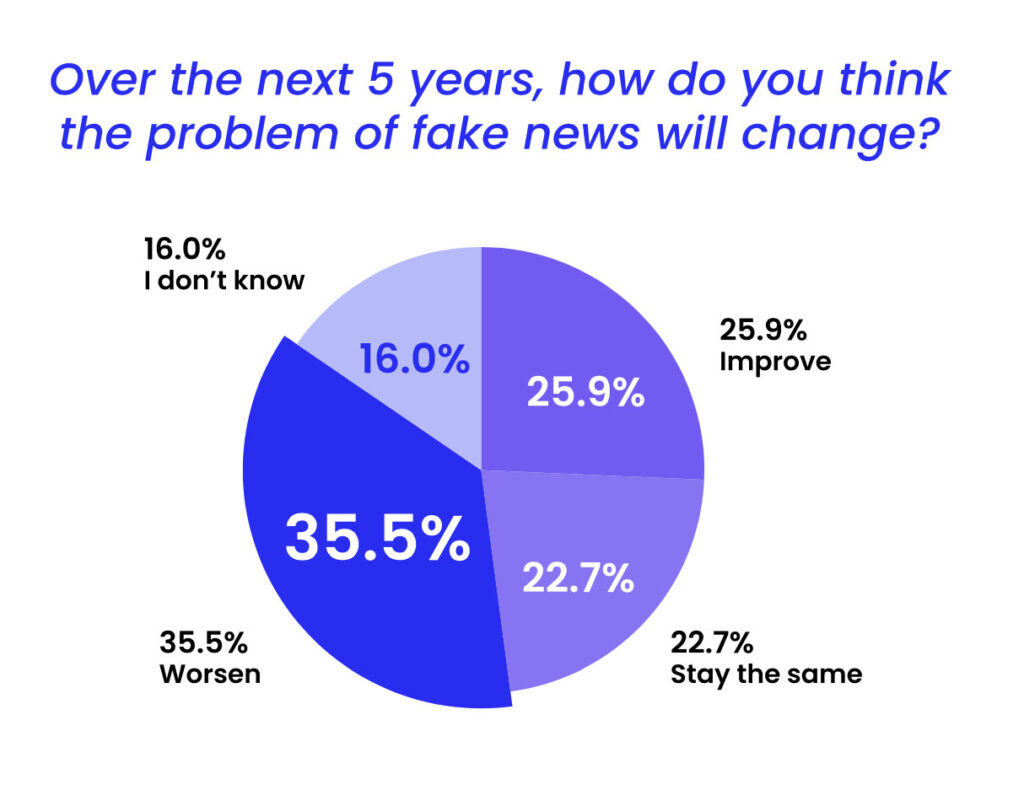
Conclusion
Fake news and misleading information abounds on the internet, and it seems like everyday people are pulled into its grasp more than they think they are. Fake websites, misleading headlines, doctored photos and video, and content that looks and feels real is having its effect on how individuals interact with information on the internet and how they respond to the world around them. But fake news doesn’t just affect the mundane. When the spread of misinformation is seen as being more of a threat than terrorism and as something that swayed a national election, you can’t just sit back and accept that it’s just going to be the reality going forward.
Some of our respondents told us that their reaction to fake news was to research, to find out the facts behind the content, who published it, what changes were made, could the data be sourced, and was it written by a reputable author. That focus on transparency — demonstrating why the content is trustworthy — is what will lead us to an internet where people don’t have to question if what they’re viewing is truthful, well-sourced, and reflects reality.
Fake news is a solvable problem. We just need to make sure that consumers are given proof of the validity of what they’re reading or watching, and that content creators are providing it.